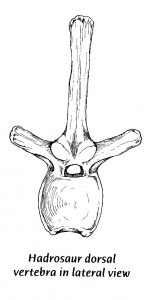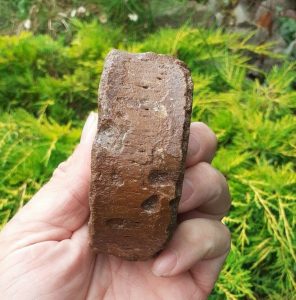In July of 2021 several secular news outlets reported with great fanfare the finding of another dinosaur bone near Mitchell, Oregon. The location was the Hudspeth formation just 300 feet from where the supposed dinosaur toe bone was found in 2015. The discovery of the toe bone was officially published in 2018. The initial report on the new finding was that it was a dinosaur vertebra, and that the University of Oregon was expected to release more information about the fossil bone in a few weeks.
The original toe bone was identified as being from an Ornithopod type of dinosaur and that seemed to be the expectation of the vertebra as well. Weeks went by and I heard nothing new about the finding. On October 3, 2021 I sent the following email to Professor Gregory J. Retallack at the University of Oregon: “I noticed the article dated July 2, 2021 about the dinosaur vertebra discovered on BLM land near Mitchell, as noted in The Times Journal. Could you please send me any information in addition to that in the newspaper article? I am especially interested in any photos that are available of the fossil.”
A few days later Professor Retallack emailed me back saying that they were still doing research on the fossil. He said nothing else about the vertebra but did enclose the paper that he had published on the toe bone in The Journal of Vertebrate Paleontology in 2018. I took this to mean that there was at this time no formal information on the Oregon dinosaur outside of the toe bone. An Internet search of the University of Oregon “Condon Fossil Collection Digital Catalog” showed the toe bone as the only Oregon dinosaur fossil found and catalogued in the U of O listing (catalog #118600).
The original newspaper article said that the amateur paleontologists that found the vertebra were from the North American Research Group (NARG). I looked on the NARG website and their Facebook page and found nothing regarding either the toe or the vertebra. But, the NARG Internet search did result in me discovering a 7 minute 54 second YouTube video by NARG called “Search for the Mitchell Ornithopod.” What I learned from the video was that the new find consisted of what was thought to be a dinosaur vertebra centrum. The centrum is the lower part of the vertebra that looks like a drum. The images below illustrate a typical Ornithopod vertebra with centrum.
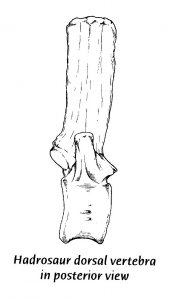 The images that follow next show replica and real fossil vertebrae for the Edmontosaurus dinosaur so one can get a feel for what a complete vertebra and a centrum only look like.
The images that follow next show replica and real fossil vertebrae for the Edmontosaurus dinosaur so one can get a feel for what a complete vertebra and a centrum only look like.
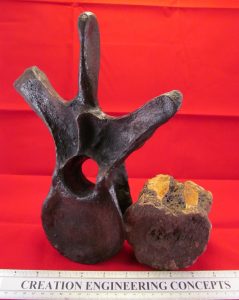 Edmontosaurus complete vertebra on left and centrum only on right
Edmontosaurus complete vertebra on left and centrum only on right
 Edmontosaurus vertebra replica and partial vertebra with spinal cord
Edmontosaurus vertebra replica and partial vertebra with spinal cord
As I continued my search for information on the possible Oregon dinosaur vertebra centrum, I found an article on an official University of Oregon website with the address https://around.uoregon.edu. The title of the article was “UO-led Team Uncovers New Pieces of Oregon’s Dinosaur Puzzle.” This was a story about the dinosaur centrum discovery and had an actual image of what I assume is the fossil that was found. This image is below:
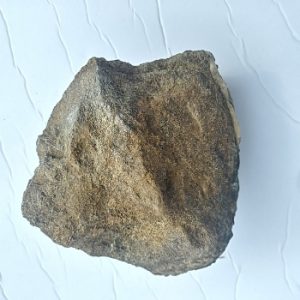 Oregon Dinosaur Vertebra Fossil
Oregon Dinosaur Vertebra Fossil
I would hope that most people would agree with me that if this is a dinosaur vertebra centrum it is a very incomplete one! It is no wonder that no additional information is available from the U of O on this.
If you have read my book Discovering the Animals of Ancient Oregon you may remember my section on the Mitchell Plesiosaur (Chapter 19, pages 235-244). U of O experts believe they have found a plesiosaur tooth (U of O catalog number 69537) and a plesiosaur vertebra (U of O catalog number 69538) from the same Hudspeth formation as the presumptive dinosaur toe and centrum. Is it possible that the dinosaur vertebra is from a plesiosaur instead of a dinosaur? If so, what would the centrum look like? See some images of plesiosaur centrums and a complete vertebra from Morocco below.
 Typical Moroccan Plesiosaur Vertebra Centrums
Typical Moroccan Plesiosaur Vertebra Centrums
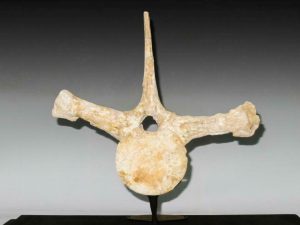 Typical Plesiosaur Complete vertebra from Morocco
Typical Plesiosaur Complete vertebra from Morocco
The U of O fossil listing also includes an ichthyosaur centrum from the Hudspeth formation (catalog number 118595). Since these and other marine type fossils are much more common than dinosaur fossils in the Hudspeth, perhaps the proposed centrum is actually from an ichthyosaur. See some samples of those below. These ichthyosaur centrums are from the United Kingdom.
Edge view of Typical Ichthyosaur Centrum from UK
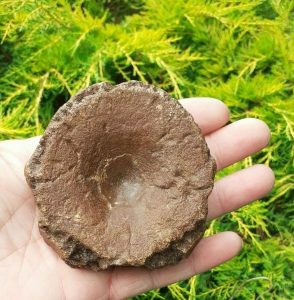 Top view of a typical United Kingdom Ichthyosaur Centrum
Top view of a typical United Kingdom Ichthyosaur Centrum
Due to the fact that the proposed dinosaur centrum was found “lodged in a strange conglomerate of pebbles, shell fragments, and compressed tree trunks that are up to a foot in diameter and 10 feet long,” Retallack has a revised explanation for how it was formed. Rather than the “bloat-and –float” model given for the dinosaur toe bone, he proposed that “this appears to have been an ancient mudflow from land that was mobilized by a storm and pushed out into the sea.”
As usual the biblical explanation for fossil formation always makes more sense than any secular explanation. All of these Hudspeth formation fossils are most likely the result of the global Flood described in the Bible. Secular science can never accept the Flood because to do so would destroy their long ages of evolution paradigm. Nevertheless, it is my conclusion the fossil found called the dinosaur centrum could be many other things, and due to this undeniable deduction we may never hear anything more about this find in an official paleontological publication.
I will continue to follow this story and write updates if possible on the ongoing Oregon dinosaur fossil search near Mitchell, Oregon. I will appreciate information updates from any of you readers on supposed dinosaur fossil finds in Oregon as well. On that note I must thank Rick Thompson from Portland for first notifying me about the latest find.
J.D. Mitchell
